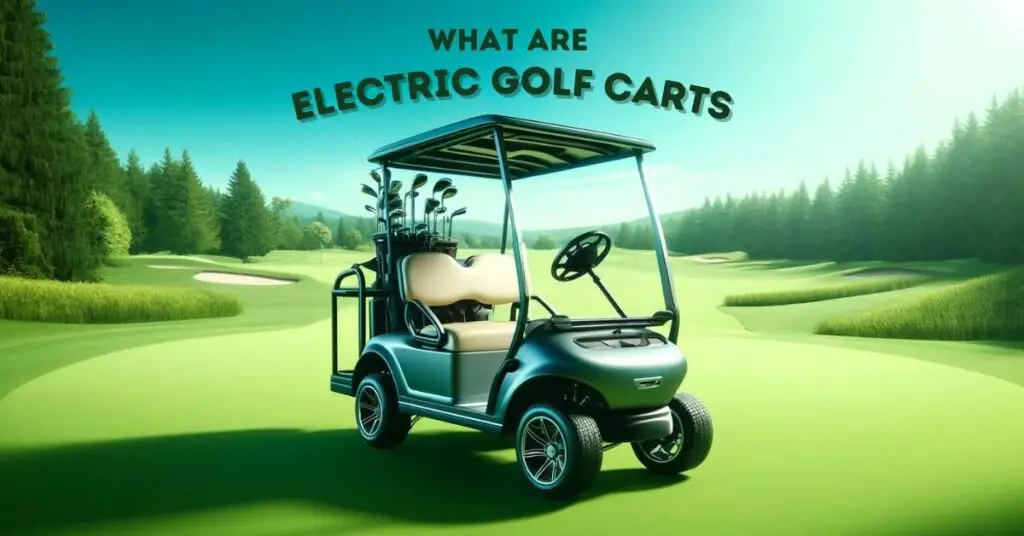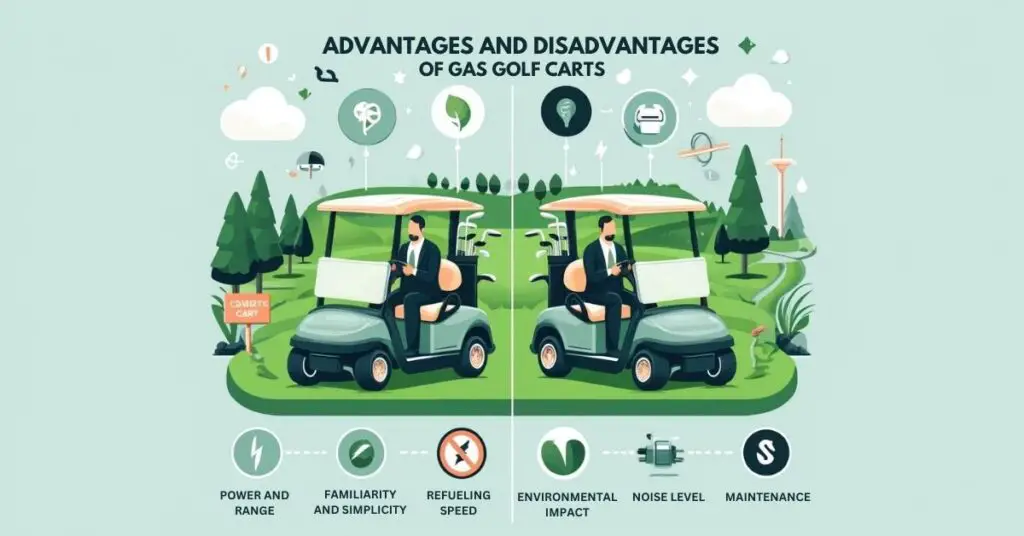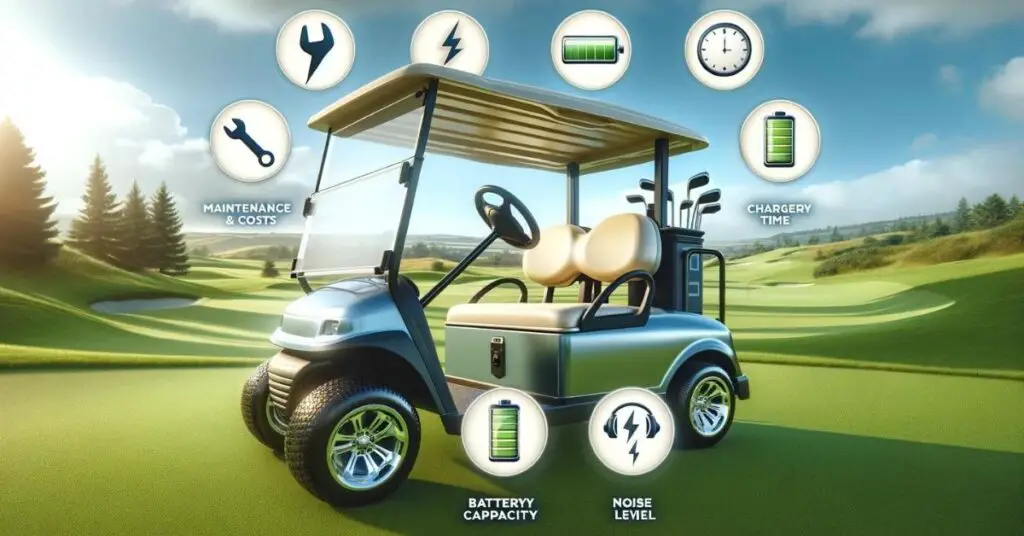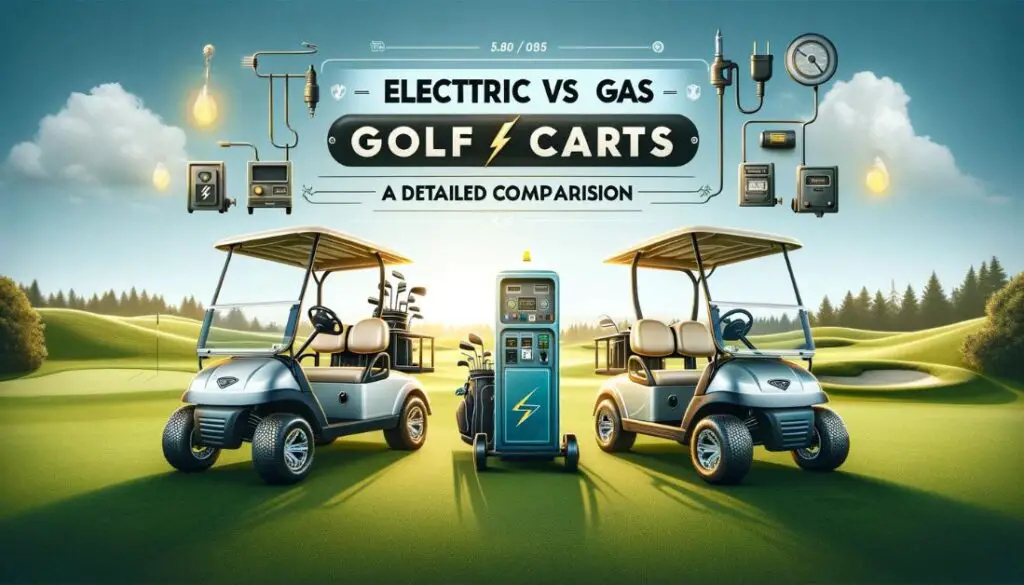In the question of electric vs gas golf carts, golfers, as well as managers of the golf course, find themselves at a crossroads. Currently, the United States has more than two million golf carts in use, so the discussion about electric vs gas golf carts is more relevant than ever.
It gets difficult to decide which type is best for use because there are so many options accessible on the market. It’s essential that you understand the differences between eco-friendly and powerhouse carts, no matter your preference. It would be fun to carry on with this golf cart comparison and provide you with the necessary information to make the best choice depending on your requirements and preferences.
Table of Contents
ToggleWhat Are Gas Golf Carts?

Gas golf carts are powered by traditional gasoline engines, similar to those found in cars but on a smaller scale. Usually, these carts carry a fuel tank that can carry several gallons of gas to minimize the number of refuels that will be required for long travel. The type of engines that are used in gas golfcarts are between 10-12 horsepower and provide significant power and torque.
This makes them ideal for the hilly terrains an also on course that are relatively long in comparison to the standard golf courses. Gas golf karts have the advantage of heavier load-carrying capacity compared to electric golf carts; however, this model allows carrying more passengers or additional equipment. But they produce exhaust smoke and are relatively louder as compared to electric vehicles. Gas golf carts require regular maintenance, like changing the oil and oil filters and engine tune-ups are some of the aspects that to make a golf cart gas powered keep running smoothly.
What Are Electric Golf Carts?

Electric golf carts are used with rechargeable batteries with the battery being made up of a series of lead-acid or lithium-ion golf cart batteries. These carts have no emissions and operations are very quiet, therefore making them eco-friendly. Electric golf carts’ normal power varies from 3 to 5 horsepower; which is sufficient for most flat courses and short distances.
Battery life is one of the main concerns of electric carts, and depending on the electric model and utilization, it gives approximately 15-30 miles of range. The time used to recharge electric carts may take a few hours or overnight depending on the battery and the charger. Electric golf carts require less maintenance and usually require battery and electrical system checks every now and then.
Advantages And Disadvantages Of Gas Golf Carts

Gas golf carts have been in use in the golfing world for many years now with the gaseous models in particular noted for their strength and reliability. However, like any option, they come with their own set of pros and cons.
Advantages:
- Power and Range: Gas carts are the most powerful as they can travel the hilly and sloppy areas easily. Larger fuel tanks store a greater number of shots per refill, suitable for extensive fairways or lengthened sessions.
- Refueling Gas Golf Cart Speed: No more waiting for a charge! get your best quality materials from the leading suppliers. These carts are easily refueled in a few minutes, at fixed fuel depots within the course, hence requiring very little time between rounds.
- Versatility: As I previously mentioned, of course, gas carts are not limited to the fairway. Due to their sturdy construction, they can be used for other purposes other than golfing such as carrying gear, doing some work around your compound, or even hunting trips.
- Familiarity and Simplicity: For users who are used to using gas-driven equipment, using gas carts is similar to what they are used to. Their mechanics are quite comprehensible to mechanics perhaps leading to easier and more affordable repairs.
Disadvantages:
- Maintenance: Like any other vehicle, gas operated golf carts need proper care once in a while- for example, oil changes, spark plug replacements, and air filter cleaning. These are the daily operating costs that are higher with the traditional gas powered golfcarts compared to electric ones.
- Noise Level: That constant roar of a gas engine golf cart can break the silence of the course and impair the actual experience of golfing particularly during early morning or in noise-sensitive areas.
- Environmental Impact: Carts that are fueled by gas emit smoke and exhaust causing pollution of the air. However, for the golfer who is conscious of this aspect of the environment, this can quite be an offense.
- Higher Upfront Cost: The maintenance costs of golf carts are also be relatively cheaper in the long run with the gas carts although they are normally more expensive to purchase than the electric carts.
Whether you choose Yamaha gas or electric golf carts, remember that electric carts are cheaper and can reach speeds of up to 20 mph, making them an efficient and economical option
Advantages And Disadvantages Of Electric Golf Carts

Electric golf carts have become more appreciated due to their environmentally friendly nature and ease of maintenance In recent years. However, like any normal car, they have their own advantages and disadvantages which must be considered before buying one.
Advantages:
- Quiet Operation: Players use electric carts to move around the course to allow them to maintain the tranquility of the game and avoid disturbing nature. Because of this, they are ideal to use in areas that are sensitive to noise or during early morning play.
- Lower Maintenance: Electric carts boast fewer moving parts compared to gas carts, translating to significantly lower maintenance requirements. Say goodbye to oil changes and spark plug woes!
- Environmental Friendliness: They have no emissions during their use, which makes them environmentally friendly for golfers who are concerned about the environment.
- Improved Ride Quality: Electric carts usually provide a more comfortable and smoother ride due to the absence of a gas engine that brings along with it vibration.
Disadvantages:
- Battery Range and Charging: Electric carts rely on batteries and these have a limitation when it comes to the distance that the cart can travel on a single charge of the battery this ranges between 15 to 25 mph depending on terrain and battery health. Today, the electric golf cart range of such models can be limited, which causes so-called “range anxiety” during longer routes. Charging can take a few hours and requires access to a charging station.
- Power: Compared to gas carts, electric carts may not perform well on inclines or when they are loaded with many items. Their power output is generally lower, making them better suited for flat courses or leisure rides.
- Battery Replacement Costs: Maintenance associated with the device is cheap, replacements for the batteries especially the lithium batteries are relatively expensive. Battery capacity can also decrease over time, depending on usage and charging, which is another consideration in your long-term costs.
- Availability of Charging Stations: However, there are fewer charging stations as compared to the gasoline stations and an older course may not even have a charging facility at all. This can be a disadvantage in a sort of way because golf players normally practice on different courses.
Difference Between Electric vs Gas Golf Carts
When selecting a cart It’s essential to understand the fundamental differences between gas or electric golf cart options. With this table, you can easily compare the main features of gas vs electric golf carts and make an informed choice based on your own demand and preferences.
Feature | Electric Golf Carts | Gas Golf Carts |
Power Source | Electric batteries | Gasoline or diesel fuel |
Emissions | Zero emissions | Emit exhaust fumes |
Noise Level | Operate quietly | Can be noisy, emit engine noise |
Maintenance | Low maintenance, fewer moving parts | Regular maintenance required (oil changes, etc.) |
Operating Costs | Lower long-term costs (cheaper electricity) | Higher fuel costs over time |
Range | Limited range per charge (typically 15-40 miles) | Longer range per tank of fuel |
Charging Time | Charging required, typically 4-8 hours for a full charge | Quick refueling, typically minutes at a gas station |
Terrain | Suitable for flat terrain, less power on hills | Suitable for hilly terrain, better torque |
Environmental Impact | Environmentally friendly | Emit greenhouse gases |
Initial Cost | Higher initial purchase price | Lower initial purchase price |
Durability | Generally durable, with fewer mechanical components | Durable, with regular maintenance |
Factors To Consider When Choosing A Gas Golf Cart

When choosing any type of gas golf cart, certain factors should be considered to make sure that it suits your requirements and preferences.
Maintenance And Costs
It is crucial to consider the maintenance and costs involved when selecting a gas golf cart. Gas carts require regular engine maintenance, including oil changes, and new fuel filters, and they need to be tuned up, and this also contributes to the total cost. Also, gasoline prices and their change in fuel prices over a period could also be considered a ongoing expenses. Nevertheless, it is essential to understand that the expense and durability combined with the power of gas carts can be useful when utilizing carts for a long time.
Environmental Impact
As for disadvantages, Gas golf carts are known to emit greater amounts of pollutants into the atmosphere due to the gases they release than golf carts powered by batteries. Gas engines are more environmentally harmful than electric engines or electric motors because they release chemicals that are bad for the air quality. Regarding the impact on the environment, this is a significant element to take into consideration. People who are worried about the sustainability of their business may find it to be rather concerning.
Durability
On the aspect of durability, gas golf carts seem to have the upper hand. They are designed for tougher conditions and heavier loads compared to electric carts, thus they are fit for rough uses. The layout and powerful engines of the gas carts show that they are well built meaning that the carts can be used for long and frequently to give them the expected performance.
Terrain
The gas golf carts perform well on different types of terrains such as hills and rough terrains. They are preferable for courses that have some topographical difficulties due to their higher torque and power. If your golf course or area of use has many slopes or uneven surfaces, then it might be more beneficial to use a gas cart.
Factors To Consider When Choosing An Electric Golf Cart

As for electric golf carts, several parameters should be considered to understand whether the product meets your requirements.
Maintenance And Costs
Electric golf carts have lower maintenance requirements compared to gas carts. There’s no need for oil changes or fuel system maintenance, reducing the upkeep costs. However, the initial purchase price and the cost of replacing batteries every few years can be significant. Over time, these factors balance out against the reduced day-to-day maintenance.
Battery Capacity
One of the big factors regarding electric golf carts is the battery capacity. The distance covered by an electric cart depends on the configurative capacity like the size of the battery and the efficiency of energy utilization, this has an impact on how far you may go between charges. You can always need to check the battery capacity, this is very essential in case you plan to travel long distances.
Charging Time
The time taken for recharging an electric golf cart is another consideration. This process may take several hours and this depends on the battery and charging equipment that is in use. It is important to schedule this downtime if the cart is used actively, especially if the cart is commonly in use. Most users even charge their carts during the night in preparation for the following day’s use.
Also Read: Essential Golf Cart Battery Charging Tips You Need To Know
Noise Level
Another benefit that seems to be quite found in electric golf carts is that they are silent. In addition, the models that are electric based do not make much noise as compared to the gas carts making the experience much more enjoyable when out on the green at the golf course. This is particularly beneficial in residential areas or places where noise pollution is a concern.
Conclusion
The decision between gas and electric golf carts ultimately comes down to your specific goals and demands. Gas golf carts are strong and long-lasting, which makes them perfect for longer routes and difficult terrain. They are adaptable enough to do a variety of activities and are capable of lifting bigger weights. However, because of emissions, they need frequent maintenance, have a greater environmental impact, and can be noisy.
Other than that, electric golf carts are eco-friendly, quiet, and have lower golf cart maintenance costs. They provide a smooth ride and are perfect for flatter courses or quieter environments. The main considerations are their battery capacity, charging time, and the higher initial cost of battery replacements.
Finally, if you want power and range as well as versatility in a vehicle, then a gas golf cart could be the best for you. If you prefer environmentally friendly and looking for less noise, and easy to maintain vehicles, then the electric golf cart is for you. Awareness of these differences electric or gas golf cart will assist you to arrive at the correct decision as per your golfing needs and preferences.



